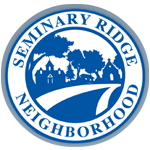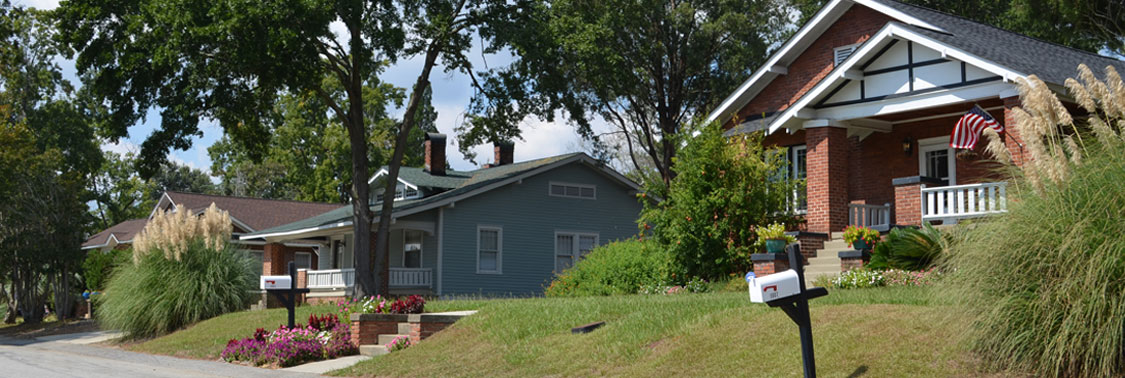History & Historical Significance
Seminary Ridge is a residential neighborhood surrounded by several major vehicular thorough-fares and featuring many historic structures, such as the late 1800’s landmark Ensor-Keenan House and other landmark buildings like the old Eau Claire Town Hall and the Eau Claire Print building. Located just above the nucleus of the small town of Eau Claire, which developed in the early 1900s, Seminary Ridge has evidence of that early development as well as continued infill throughout the early and mid-twentieth century. The Lutheran Seminary along the neighborhood’s east border has also heavily influenced the landscape and area development.
The capital city of Columbia was expanding rapidly in the early twentieth century. The vehicle age was dawning, and trolley cars were able to move large groups of people rapidly to the outlying suburbs located to the southeast and to the north of the city’s historic borders. Land developers saw the trolley lines as paths to wealth, and soon began buying up large tracts of land to create new neighborhoods along the tracks. Frederick Hargrave Hyatt was one such developer. An agent and eventual area manager for the New York Life Insurance Company, as well as a dairy farmer, Hyatt purchased a home north of Columbia in the early 1890s. He began the development of Hyatt Park and created several neighborhoods, selling off lots at auction and encouraging the growth of the area. He helped establish an electric railway line out to his developments in 1896. Hyatt donated land to Columbia College and was a dynamic force for developing the small town of Eau Claire, which was incorporated in 1899 with over 200 residents. The town’s boundary was in the shape of a circle, with its center at the intersection of North Main Street and Monticello Road.
The new town gained some significant buildings in the late 1890s and early 1900s. The Hyatt Park Pavilion, built in 1897, provided an entertainment center with a casino, vaudeville theater, orchestra and even a zoo. The next year the Hyatt Park School was completed. Columbia College moved up from their downtown location to their new property in Eau Claire, and broke ground in 1905. The Lutheran Seminary constructed its first large building in 1911, and in the midst of all the new activity, homes and churches were also being built throughout the area, including Eau Claire Presbyterian Church in 1912, St. Paul Baptist Church in 1911, The Lutheran Church of the Ascension, completed in 1913, and others. While the churches were wood framed, wood-sided buildings, the schools were generally masonry buildings with imposing facades, lending a sense of stability to the new town. Its independence was somewhat brief, however, as the City of Columbia incorporated a portion of Eau Claire in 1913, along with suburbs located east and southeast of the city, including Shandon, Waverly and South Waverly.
The area that is now the neighborhood of Seminary Ridge is located in between the two major thoroughfares within Eau Claire, the two roads whose intersection formed the original center point of the town. Just north of the intersection, the ornately decorated brick American Lutheran Survey building, later the Eau Claire Town Hall, was completed in 1914, followed later by the Survey Publishing Building. North of these buildings the neighborhood of Seminary Ridge begins, and residences have remained along this southern border since around the 1920s. Originally, the neighborhood’s southern border created a narrow point at the town’s center. A plat map from 1910 indicates that the Monticello Home Company owned the entire area forming a triangle between North Main Street, Ensor and Arlington (west boundary) and Calhoun Street (later Timrod Street), excluding the Lutheran Seminary campus. The Ensor-Keenan House, reportedly built in the late 1860s and rebuilt in 1891 after a fire, was on part of the west boundary of the neighborhood. The Monticello Home Company hired an Ohio landscape engineer to draw up the plan, and his plat shows there were to be fairly regularly sized lots, with sidewalks and trees lining the streets. Monticello was the name of the new neighborhood, and playing on the presidential theme it evoked, original street names included Mt. Vernon and Jefferson (later changed to Calhoun, and changed again to Timrod).
The earliest homes in the area were built adjacent to each other on Muller Avenue, by the Cannon family. Though somewhat altered, these homes remain today. Churches and the Lutheran Seminary also began building in the area during the early 1900s, with the addition of the Lutheran publishing building by the 1910s. The City of Columbia annexed part of Eau Claire in 1913, with the remainder annexed in 1955. Between those periods the neighborhood continued to gain new houses. Bungalows built during the 1920s appear concentrated in the southern part of the neighborhood, along Jackson, Duke and Hillcrest Avenues, as well as their western border, Ensor Avenue. The Great Depression brought construction nearly to a halt, though a few buildings were added along North Main Street, Arlington, Wildwood and Sycamore. Construction picked up during the 1940s and 1950s, with homes filling in along Sycamore, Wildwood, and Ensor Avenue. Timrod gained some homes during the 1950s and 1960s, though its hilly topography seemed to deter consistent development. Reportedly in 1961, President John F. Kennedy tried to boost the steel industry with the re-introduction of steel houses, with seven buildings being built across the nation. One of them is on Timrod Street, and it is strikingly similar to the all-metal Lustron homes created during the 1940s.
The Lutheran Seminary reportedly housed professors in homes in the neighborhood and has undoubtedly contributed to the neighborhood throughout the years. Its campus has created somewhat of a calming buffer between the neighborhood and busy North Main Street. The campus extended into the neighborhood in the late 1990′s when it removed all of the homes on Hillcrest Avenue to build student housing. As a result, Hillcrest Avenue no longer exists. There are a few vacant lots in the neighborhood that have been filled in with new housing within the past decade or so, but generally the area retains much of its historic buildings and wide, peaceful streets.


